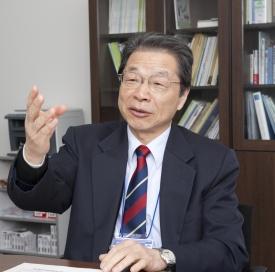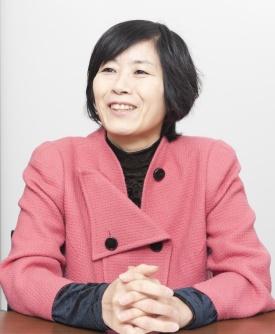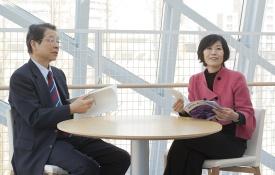

01/30/2012
AIMResearch: The WPI-AIMR recently celebrated its fourth anniversary. What are the most notable research achievements made at the institute since it opened?

Yamamoto: The WPI-AIMR gathers a wide variety of world-class researchers under one roof to carry out cutting-edge research across a range of topics in materials science, and we have published a large number of papers in leading international journals. However, there are some discoveries that particularly stand out. For example, one of our young assistant professors, Seigo Souma, who works in Takashi Takahashi's group, has recently made an extremely important breakthrough in pure research in understanding the mechanism that underpins the phenomenon of high-temperature superconductivity (HTSC). At the WPI-AIMR, we have built the highest resolution Angle-Resolved Photoelectron Spectroscopy (ARPES) set-up in the world, and Souma and his team have used this to establish the important role that electron spin plays in HTSC. Another noteworthy result is the discovery of new materials by Terunobu Miyazaki's group which can be applied to so-called ‘normally-off’ computers. As you know, conventional computers have to be switched on all the time to work, but as their name suggests, normally-off computers only draw power when it is absolutely necessary for memory operations. It is expected that these normally-off computers will consume up to 70% less power than existing machines.
AIMResearch: Earlier this year the Mathematics Group, under the direction of Professor Kotani, was added to the existing four research divisions at the WPI-AIMR. How is the new group developing and how is it expected to change the way the institute operates?
Kotani: The Mathematics Group is already working actively with colleagues in other groups, such as the Applied Mathematics Forum at Tohoku University. We will soon have three principal investigators, including myself, as well as two associate professors and three assistant professors, and our plan is to eventually add postdoctoral researchers and PhD students who will use mathematics to better explain the theoretical underpinning of the experimental work carried out at the institute. We hope that analyzing materials science at the most fundamental level will allow us to predict the future direction projects should follow to get the best results in the most efficient way possible.
Yamamoto: A good example is Seigo Souma’s work on HTSC. The standard approach for this application would be to carry out various trial-and-error experiments and gradually move towards more efficient superconductors. However, this can be an unreliable, expensive and time-consuming approach. If we can increase the accuracy of our theoretical models for HTSC, it may help us to focus on higher-performing systems that would otherwise take us much longer to find.
AIMResearch: The WPI-AIMR actively pursues new approaches to create a world-class research environment. What steps have been taken to achieve this and what challenges have you faced along the way?
Yamamoto: Creating the right sort of research environment is probably the biggest challenge we have ever faced. One of the most concrete examples is the magnificent new research facility we are now sitting in. Having all of our researchers here under one roof is vital for carrying out ‘fusion’ research.

Kotani: Our plan for the new building was to feature at the very heart of the design the idea of encouraging free discussion and exchange. This is reflected in the open-plan areas where researchers can meet and talk informally over coffee, but with a whiteboard in reach to aid discussion. In many Japanese universities, this kind of informal meeting area is often considered a waste of valuable space, but for us it is an indispensable part of the research environment. Cultivating a new kind of fusion research culture that can lead to new breakthroughs and also challenge the status quo in Japanese universities is one of the central aims of the WPI program as a whole, and as such it is vital to our success as an institution.
Yamamoto: Another big challenge we have faced is how to create an environment that is welcoming to overseas researchers. We have implemented a number of initiatives to help our non-Japanese staff and students. For example, we have adopted English as the official working language within the center to enable easier communication. We are also building a new international house for foreign students and staff.
Kotani: Currently we are focusing on personalizing administrative support at the WPI-AIMR. Previously it was difficult for our researchers to find out whom to approach for assistance, so now we are ensuring that the roles of support staff will be more clearly delineated and identifiable.
AIMResearch: How was the WPI-AIMR affected by the 2011 Tohoku earthquake and how well is it recovering?
Yamamoto: The earthquake caused widespread devastation and loss of life in the Sendai area and the wider Tohoku region. Immediately after the earthquake, we briefly halted operations to check the damage and ensure the safety of our staff and students. Some of our overseas members returned temporarily to their home countries; however, we were able to reassemble most of the teams within a few weeks after the disaster and return to work, although severe aftershocks continued for several weeks. Whilst the actual buildings of the institute escaped largely unscathed, some of the facilities and equipment were severely damaged.
Kotani: Despite the heavy financial burden from the earthquake, we were determined to minimize its effect on our research output. We had to think creatively about how we could best use the equipment that was still intact, for example, by learning to use our equipment in new ways. Some staff took the opportunity to focus on analyzing existing data and writing up papers while they were waiting for equipment to be repaired or replaced. As a center, we felt a very strong sense of responsibility to people in the Tohoku region to play our part in the rebuilding effort, and the best way we could do that was to continue our research.

AIMResearch: Next year the WPI-AIMR will have new leadership as Professor Kotani takes over as director of the institute. What plans does the WPI-AIMR have for expansion in the next 5 years?
Yamamoto: The institute will probably remain at its current size of about 200 members. However, we still have to focus on developing the WPI-AIMR so that it can influence our university and others in Japan. Institutions in East Asia need to rethink their approach to learning and research in order to compete with those in the USA and Europe. To address this issue, we aim to set up institutions that will help transform the research culture of Japanese universities.
Kotani: Our overarching research theme at WPI-AIMR will be “Building the future through materials”. We will also increasingly use mathematics to improve the accuracy and reliability of our theoretical models, and to improve the predictability and efficiency of our experimental work. Through this WPI-AIMR will become an unprecedented model of research institute which combines mathematics and materials sciences. Going forward, I want the WPI-AIMR to become a center like no other in the world, one that attracts the very best and most ambitious researchers from across the globe to develop new materials that, rather than simply fulfilling a need, actually change the way we look at the world around us.